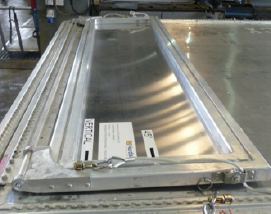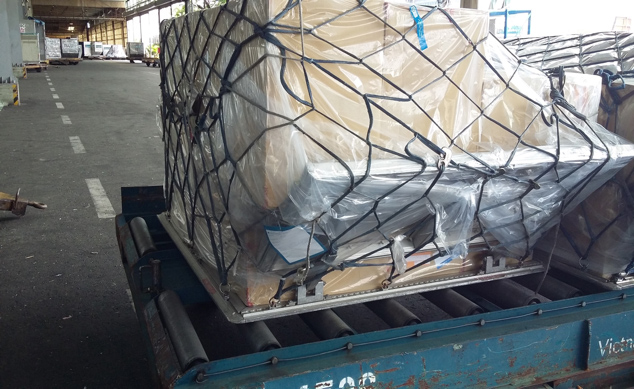Accessories, Cargo Terminals, Freight Forwarders, CARE, Ground Handlers, ULD Service providers
Pallet Wings – adding extra volume to lower deck loads
Pallet extenders or “wings”, as they are commonly called, have been in use for many years, providing an effective method to increase the useable volume of pallets in lower deck positions. Generally available for use on any size of pallet, these are most commonly used on PAG/PMC and also PKC (A320) pallets.
On a PMC pallet, the ability to securely build a lower deck load to match the full available contour (“F”), compared to building vertical sided loads, will add about 3 CuM, or 30% more volume, leading to industry wide practice of building overhanging loads- something that has gone on in certain air cargo markets for years.
However, overhanging lower deck pallet loads are not without problems, most specifically where the load collapses during surface or air transport. This can lead to all sorts of problems, such as:
- Damage to the aircraft hold liner, which requires costly repairs
- Pallet stuck in the aircraft when cargo comes into contact with the hold liner
- Full or partial collapse of the loaded pallet during surface transport
All of which can be avoided by the use of pallet wings.
The basic requirements for pallet wings are that they shall provide adequate support under the overhanging part of a loaded pallet, yet shall be capable of being folded down when not in use so that empty pallets can be stacked on top of each other. This is a simple enough set of requirements but as always there are more than a few details to be considered.
The IATA ULD Regulations Section 60/1 contains a comprehensive set of technical specifications that have been developed based on SAE AS 1988. There are no separate certification requirements published for pallet wings. They are considered as part of the pallet load when contained inside the pallet and net assembly.
The earliest pallet wings were essentially “home made” affairs fabricated locally out of plywood sheet and often for “one way” use; however, before long, a number of ULD manufacturers developed designs fabricated in aluminum that are both stronger and more durable. The basic concept for most pallet wings is that of an aluminum frame which is hinged along its lower side. The bottom of the wing is attached to the pallet seat track through 2-3 hinged brackets and the angle of the opened wings is controlled by cables that run from attachment points (locked 2 stud fittings) on the long sides of the pallet to the sides of the wings near its top.
often for “one way” use; however, before long, a number of ULD manufacturers developed designs fabricated in aluminum that are both stronger and more durable. The basic concept for most pallet wings is that of an aluminum frame which is hinged along its lower side. The bottom of the wing is attached to the pallet seat track through 2-3 hinged brackets and the angle of the opened wings is controlled by cables that run from attachment points (locked 2 stud fittings) on the long sides of the pallet to the sides of the wings near its top.

Designs vary but in general, pallet wings can be adjusted to suit both “U” (B747) , “F” ( most other wide body) contours as well as offering a vertical position and, for stacking, a folded down position. There are also some designs of pallet wings that use a mechanism to provide a horizontal shelf configuration rather than a sloped panel.
While a pallet wing may seem a simple enough device there are a number of considerations required for their proper use:
- Unless specifically otherwise designated, a pallet wing must be considered as a noncertified device. This means that the wing and its contents must be completely enclosed by a certified air cargo pallet net that is attached directly to the pallet seat track, and not directly to the pallet wing.
- The cargo net used with the pallet and wings needs to have sufficient “body” so that it can reach around the extended contour- as a lower deck load will be 64” high, this means the net will need to be a minimum 80” or 96” high.
- Never use a forklift to lift or push the loaded winged pallet. Unfortunately the small gap between the bottom of the wing and the pallet edge rail may appear as a handy place to insert a forklift tine to lift or push the loaded pallet, but this will put extremely high loads onto the hinges connecting the wing to the pallet and can easily lead to costly damage.
- When folded down, the support cables must always be stowed so that they do not extend beyond the edges of the pallet where they may be snagged.
- In general pallet wings are used with relatively lightweight volumetric cargo and thus overloading of the pallet wings should not be a concern. However, at the same time any deflection of the wings towards the aircraft holds liner is very serious. Therefore before use, a pallet wing needs to be carefully inspected for any damage, most specifically
- Any bends or cracks in the structure and/or attaching brackets
- Any tears/jagged metal on the wing sheet
- Any fraying or other deterioration in the cables that maintain the wing in the correct position
- Any looseness/insecurity of any fasteners or parts that support the wing during use.
- Any signs of damage to the pallet edge rails
Never use a pallet wing that has any of the damage listed above.
Pallet wings or extenders provide the industry with an effective method by which the maximum contour of aircraft lower holds can be utilized without the use of structural containers and without incurring the risk of overhanging loads collapsing during either the surface or air transportation.

However, like any item of ULD, they require proper use and attention, and failure to follow simple procedures can lead to significant consequences.


